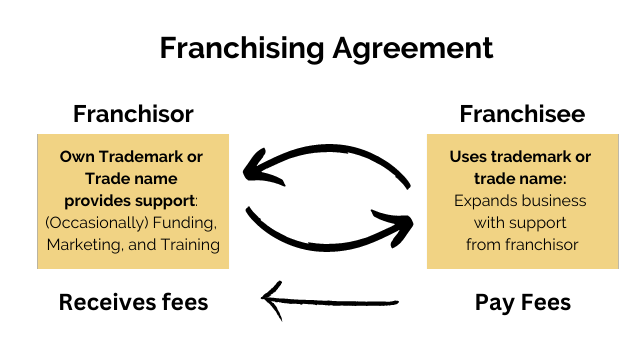Please note that the templates and content provided on this hub are intended for reference purposes only and should be customized to suit the specific needs of your business. While we strive to provide accurate and up-to-date information, it is important to understand that the templates and content are not a substitute for professional legal or financial advice. This info has been provided by grafterr.com
Franchising is a standard business model that enables entrepreneurs to expand their businesses while sharing the risks and rewards with franchisees.
To ensure your success as a franchisor, there are a number of factors you must know before entering the franchising industry. In this article, we will discuss the fundamentals of franchising, how to develop a successful business concept, how to create a solid franchise system, legal considerations, selecting and supporting franchisees, managing growth and expansion, building a positive brand image, financial considerations, ethical considerations, and the challenges and opportunities in franchising.

Understanding the Fundamentals of Franchising:
Who is a Franchisor and How Does the Business Model Work?
Prior to delivering the advance information, we must ensure that you comprehend the fundamentals of the franchising industry and who a franchisor is. The business model of franchising involves a franchisee paying a franchisor for the right to use the franchisor’s business model, brand, and intellectual property. The franchisee is required to operate their business according to the franchisor’s established system and to adhere to the franchisor’s established policies and procedures.

In contrast, the franchisor is the proprietor of the business concept and permits the franchisee the right to use it for an initial fee and ongoing royalties (Management service fees). The franchisor provides training, support, and ongoing assistance to the franchisee to ensure that the franchisee administers the business according to the franchisor’s standards.
In exchange, the franchisor enjoys the franchisee’s ongoing fees and the expansion of their business through the opening of new franchise locations.
There are two primary franchise types: product distribution and business format. In product distribution franchising, the franchisee sells the franchisor’s products, whereas in business format franchising, the franchisee runs a business using the franchisor’s trademark, products, and processes.

Advantages of franchising include:
- Faster growth: Franchising allows entrepreneurs to expand their business quickly without the financial and operational risks of opening new locations themselves.
- Shared risk and reward: Franchisees invest their own money in the business, which means they are motivated to succeed. Franchisors benefit from the franchisee’s success through ongoing royalties.
- Consistency: Franchisees follow a proven business model, which helps maintain consistency in the brand image and customer experience.
Disadvantages of franchising include:
- Loss of control: Franchisees operate their businesses independently, which means franchisors have less control over day-to-day operations.
- Legal compliance: Franchisors are responsible for complying with franchise laws, which can be complex and time-consuming.
- Financial costs: Franchisors incur significant upfront costs, such as developing training programs and operations manuals, and ongoing expenses, such as supporting franchisees and marketing the brand.

From concept to reality:
building a strong franchise system for food and beverages services industry.
To build an effective franchise system, you must define the franchise model, create a franchise agreement, develop operations manuals, and establish training programmes.
- Seek Legal Advice: Writing a franchise agreement is a complex legal process that requires the guidance of an experienced franchise attorney. They can help you navigate the legal requirements and ensure that your agreement is compliant with all relevant laws and regulations.
- Define the Business Model: The franchise agreement should clearly define the business model, including the products and services offered, pricing, branding, and marketing strategies.
- Establish Operational Standards: To ensure consistency and quality across all franchise locations, it is critical to establish clear operational standards for everything from food preparation and customer service to staffing and inventory management.
- Outline Training and Support: A comprehensive training program is essential to ensure that all franchisees and their staff are equipped with the knowledge and skills needed to operate the business successfully. The franchise agreement should outline the training program and ongoing support provided by the franchisor.
- Determine Management service fees: The franchise agreement should clearly define the initial franchise fee, ongoing royalties, and any other fees associated with the franchise relationship.

What to Consider Before Writing a Franchise Agreement
Before writing a franchise agreement, it is essential to consider the following factors:
- Market Research: Conduct thorough market research to determine the demand for your food and beverage concept, and identify potential franchisees and target markets.
- Financial Projections: Develop a solid business plan and financial projections to ensure that the franchise model is viable and profitable for both the franchisor and franchisee.
- Intellectual Property Protection: Protect your intellectual property through trademarks, copyrights, and other legal protections.
- Branding and Marketing: Develop a strong brand and marketing strategy that will resonate with your target audience and set your franchise apart from competitors.
There are two main types of franchising arrangements: single-unit (direct-unit) franchises and multi-unit franchises. Each type of franchise agreement has its own benefits and challenges. Understanding the differences between the two types of franchising arrangements can help potential franchisors make an informed decision about which type of franchise best suits their goals and resources.
- Single-Unit (Direct-Unit) Franchise: This type of franchise agreement involves a single franchisee owning and operating one franchised unit. The franchisee has the right to use the franchisor’s trademark, products, and systems in one location. The franchisee is responsible for all aspects of the business, including site selection, build-out, staffing, marketing, and day-to-day operations. The franchisor provides support and training to ensure that the franchisee is successful.
- Multi-Unit Franchise: In this type of franchise agreement, a single franchisee owns and operates multiple units under the same franchise agreement. The franchisee has the right to use the franchisor’s trademark, products, and systems in multiple locations. The franchisee is responsible for all aspects of the business, including site selection, build-out, staffing, marketing, and day-to-day operations. The franchisor provides support and training to ensure that the franchisee is successful across all units.
There are several benefits to owning a multi-unit franchise, including the ability to leverage economies of scale and reduce operating costs by sharing resources and staff across multiple locations. However, it also requires a higher level of financial investment and operational expertise. A single-unit franchise, on the other hand, may be a more manageable investment with lower financial risk. Ultimately, the decision to pursue a single-unit or multi-unit franchise depends on the franchisee’s financial resources, experience, and business goals.
Writing a Franchise agreement
Writing a franchise agreement is a complex and detailed process that requires careful consideration and legal expertise. The franchise agreement is a legally binding document that outlines the rights and responsibilities of both the franchisor and the franchisee. The franchisor should determine the terms of the agreement, including the length of the agreement, renewal options, and the franchise fee.
The agreement should clearly outline the rights and obligations of both the franchisor and the franchisee. This includes details on training, support, advertising, intellectual property, and other areas of the business.
Include a termination clause: The agreement should outline the circumstances under which either party can terminate the agreement, such as breach of contract or failure to meet performance standards.

Review and revise the agreement: Once the agreement is drafted, it should be reviewed and revised by legal counsel to ensure that it is legally sound and protects the interests of both parties.
Sign the agreement: Once both parties agree to the terms of the agreement, it should be signed and executed by both parties.
Overall, writing a franchise agreement is a complex process that requires careful consideration of all aspects of the franchisor-franchisee relationship. Working with experienced legal counsel can help ensure that the agreement is legally sound and protects the interests of both parties.

Grafterr, offers a free Franchise Agreement Template specifically designed for food and beverage businesses. This template can serve as a starting point for franchisors who are new to the process, providing a clear framework for drafting a comprehensive and legally sound agreement.
Using a template can help ensure that all necessary elements are included in the franchise agreement, while also saving time and reducing legal costs. It is still recommended to work with an experienced attorney who can review and revise the agreement to ensure that it complies with all relevant laws and regulations. By combining the use of a template with the guidance of legal counsel, franchisors can create a strong and effective franchise agreement that sets the foundation for a successful partnership between the franchisor and franchisee.




